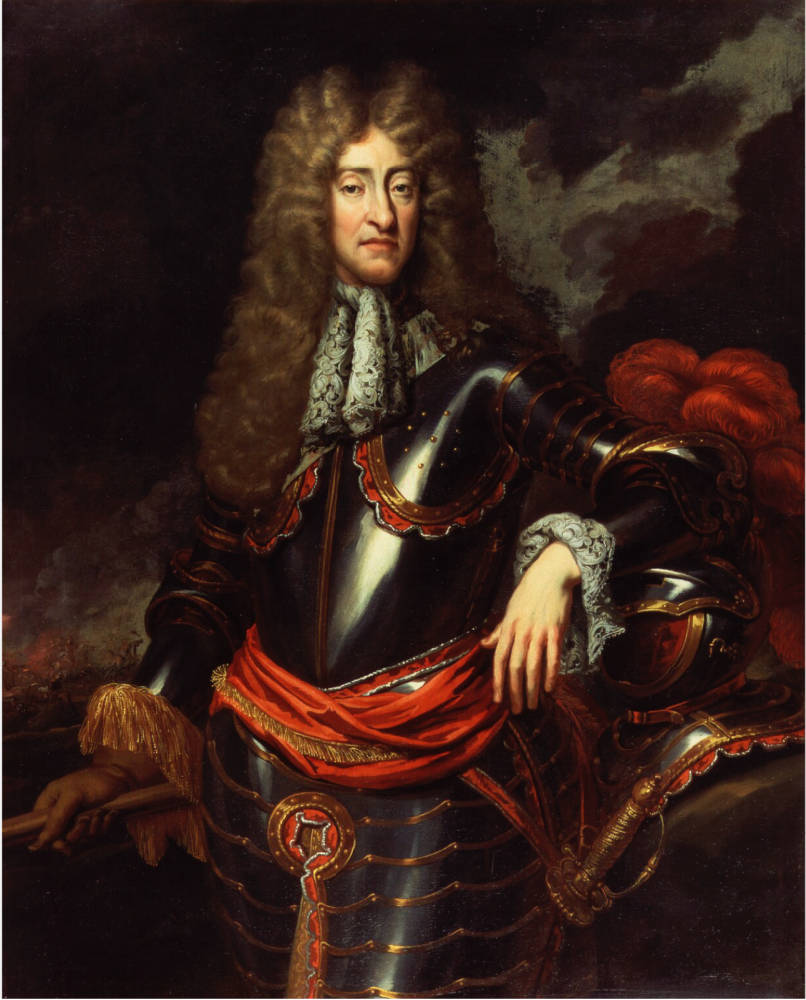 James II was born in 1633 and died in 1701: the second son of Charles I and Henrietta Maria, he succeeded his brother, Charles II, to the throne and reigned as king of Great Britain from 1685 until 1688, when he was overthrown in the Glorious Revolution. He became a Roman Catholic, probably as early as 1672. He was an able soldier and seaman, but, unfortunately for him, an inept politician. Upon his accession to the throne he promised to protect the Church of England and maintain the political and religious status quo, but in the event he could not resist the temptation to reintroduce Roman Catholicism in England. The revocation in 1685 of the Edict of Nantes had forced thousands of French Protestants to emigrate to England, intensifying the already vehement anti-Catholicism which existed there. James proceeded, ill-advisedly, to enlarge the standing army and to place Catholics within it in positions of command: after doing so, he stationed it where it threatened Protestant London. In 1687 his order to all Anglican bishops to read his declaration of indulgence from their pulpits--a declaration which, in practice, meant that Dissenters would still be persecuted while Catholicism would not only be tolerated but favored--was met with resistance by seven of the twenty-six bishops, including the Archbishop of Canterbury: those who refused to read it were thrown into the Tower of London, and immediately became national heroes. Freed after trial, they further inflamed public sentiment against him.
James II was born in 1633 and died in 1701: the second son of Charles I and Henrietta Maria, he succeeded his brother, Charles II, to the throne and reigned as king of Great Britain from 1685 until 1688, when he was overthrown in the Glorious Revolution. He became a Roman Catholic, probably as early as 1672. He was an able soldier and seaman, but, unfortunately for him, an inept politician. Upon his accession to the throne he promised to protect the Church of England and maintain the political and religious status quo, but in the event he could not resist the temptation to reintroduce Roman Catholicism in England. The revocation in 1685 of the Edict of Nantes had forced thousands of French Protestants to emigrate to England, intensifying the already vehement anti-Catholicism which existed there. James proceeded, ill-advisedly, to enlarge the standing army and to place Catholics within it in positions of command: after doing so, he stationed it where it threatened Protestant London. In 1687 his order to all Anglican bishops to read his declaration of indulgence from their pulpits--a declaration which, in practice, meant that Dissenters would still be persecuted while Catholicism would not only be tolerated but favored--was met with resistance by seven of the twenty-six bishops, including the Archbishop of Canterbury: those who refused to read it were thrown into the Tower of London, and immediately became national heroes. Freed after trial, they further inflamed public sentiment against him.
James's final downfall, however, came about as the result of fears about the succession to the throne. He had had two Protestant daughters by his first wife, and in the normal course of events the elder would have become Queen, but in 1688 his second, Roman Catholic, wife unexpectedly gave birth to a son: various powerful figures within and without the government, faced with the prospect of a tyrannical Catholic dynasty, treasonously invited William of Orange, the staunchly Protestant son of the daughter of Charles I, to assume the throne: James, finding himself bereft of political and military support, fled, though he stopped to throw the Great Seal of England into the Thames. He was captured by some fishermen, however, before he could cross the Channel, and was brought back, ignominiously, to London, but William, having no wish to make him a martyr or a center for Catholic resistance, contrived to let him escape again. It was announced that he had abdicated, and the throne was officially declared vacant, though it was of course immediately occupied by William and Mary. The unhappy James lived out his life in exile at the court of Louis XIV.
Was James II the source of religious toleration?
In his review of Scott Sowerby's Making Toleration, Jonathan Clark asks, “Where did religious toleration come from? . . . Was it from James II, abhorring wars of religion and impatiently using his prerogative powers to drive through toleration, a 'grand solution', in the face of a recalcitrant, because Anglican-dominated, Westminster Parliament?” According to Sowerby's “able and important work,”
the Revolution of 1688 was "enabled" by James's reforms, not by his oppressions, as the Church of England adopted a posture of implacable opposition. The Toleration Act, passed in 1689 after the installation of William and Mary, now emerges as a forced tactical response to James's campaign, not a reward for Dissenters' previous hostility to James, and not inspired by Locke's Epistola de Tolerantia; indeed, it left a sacramental test still standing, the opposite of what the repealers had sought. Religious toleration was still some two centuries off. Sowerby is clear in his verdict: the Revolution "was not primarily a crisis provoked by political repression. It was, in fact, a conservative counter-revolution against the movement for enlightened reform that James himself encouraged and sustained.
Related material
- The Glorious Revolution
- Macaulay on the Peculiar Nature of the Glorious Revolution
- “Vicious Theory and Vicious Practice”: Macaulay on James II and Seventeenth-Century Anti-Catholicism
- Macaulay on James II and Seventeenth-Century Anti-Catholicism
- James II
- Historical Novels about Cromwell, the Civil War, and Restoration, 1830-1870
Bibliography
Clark, Jonathan. “A New James” Times Literary Supplement (14 June 2013): 28.
Sowerby, Scott. Making Toleration: The Repealers and the Glorious Revolution Cambridge, MA: Harvard University Press. 2013.
Created 1987; image added 1999; new material added 22 November 2020